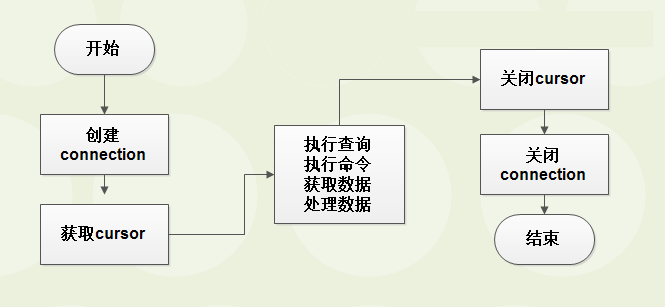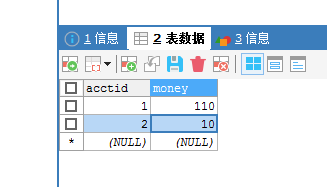实现一个简单的银行转账操作
原文发表在 我的博客主页 ,转载请注明出处。
前言
在进行一个应用系统的开发过程中,从上到下一般需要四个构件:客户端-业务逻辑层-数据访问层-数据库,其中数据访问层是一个底层、核心的技术。而且在实际开发中,数据库的操作也就是说数据访问层都是嵌套在其他语言中的,其是编程的核心。本文面向的是python语言,即通过python操作数据库来实现简单的银行转账操作。
工具
python提供了python DB API用来统一操作数据库,使访问数据库的接口规范化,在没有python DB API之前,接口程序十分混乱,不同的数据库需要不同的操作接口,所以这个接口提供了极大的方便。在具体操作的时候,我们需要操作数据库以及其他逻辑的python代码,数据库连接对象connection来建立连接,数据库交互对象cursor来“运送”数据,一个健壮的系统必不可少的便是数据库异常类Exceptions。整个访问数据库流程如下图:

接下来分别介绍下两个主要对象:
- connection:数据库连接对象,建立python客户端与数据库的网络连接。
创建方法:MySQLdb.connect(),包括的主要成员方法:- cursor():使用该连接创建并返回游标
- commit():提交当前事务
- rollback():回滚当前事务
- close()关闭连接
- cursor:游标对象,用于执行查询与获取结果,cursor对象支持的主要方法如下:
- execute():执行SQL语句,将结果从数据库获取到客户端
- fetchone():取得结果集的下一行
- fetchmany(size):获取结果集的下size行
- fetchall():获取结果集中剩下的所有行
- rowcount:最近一次execute返回数据的行数
- close():关闭游标对象
在上面的方法中提到了一个关键名词:事务,什么是事务呢?他是访问和更新数据的一个程序执行单元,很多操作的一个集合,有四个特点:
- 原子性:事物中包括的诸操作要么都做,要么都不做
- 一致性:事务必须使数据库从一致性状态变到另一个一致性状态
- 隔离型:一个事务的执行不被其他事务干扰
- 持久性:事务一旦提交,它对数据库的改变就是持久性的
事务的上述特点正是我们完成银行转账操作的关键。
具体实现
在开发中我们怎么样使用事务呢?
- 关闭自动commit()
- 正常结束事务:conn.commit(),
- 异常结束事务:conn.rollback()
在银行转账系统中,需要考虑如下需求:比如A给B转账,当A账户上减少了M钱时,必须在B账户上多了M钱,不能A减了B没加,也不能B加了A还没有减,当然账户必须是有效的,M钱的金额肯定要大于A账户上的金额。所以在具体设计的时候,需要将A账户的金钱减少和B账户的金钱增加作为一个事务,要么同时成功,要么一起失败。按照这个需求,书写代码,详细代码见 github ,代码复制和数据库如下,有两个账户,分别拥有金钱110和10,在运行代码的时候在参数栏输入1,2,100(source_acctid, target_acctid, tranfer_money)。

整个代码的逻辑如下:首先连接数据库,之后执行逻辑,然后断开数据库连接,执行的逻辑包括检查转账双方的账户是否有效,转账金额是否多于转账人的账户余额,分别给转账双方的帐号金额发生变化。如果正常结束事务,提交修改数据库,否则回滚。
#coding:utf-8 import sys import MySQLdb class TransferMoney(): def __init__(self, conn): self.conn = conn def transfer(self, src, target, money): try: self.check_acct_available(src) self.check_acct_available(target) self.has_enough_money(src, money) self.reduce_money(src, money) self.add_money(target, money) self.conn.commit() except Exception as e: print e self.conn.rollback() def reduce_money(self, src, money): cursor = self.conn.cursor() try: sql = "update account set money = money - %s where acctid = %s" %(money, src) cursor.execute(sql) print "reduce_money: " + sql #rs = cursor.fetchall() if cursor.rowcount != 1: raise Exception("the account reduce money fail") finally: cursor.close() def add_money(self, target, money): cursor = self.conn.cursor() try: sql = "update account set money = money + %s where acctid = %s" %(money, target) cursor.execute(sql) print "add_money: " + sql #rs = cursor.fetchall() if cursor.rowcount != 1: raise Exception("the account add money fail") finally: cursor.close() def check_acct_available(self, accit): cursor = self.conn.cursor() try: sql = "select * from account where acctid = %s" %accit cursor.execute(sql) print "check_acct_available: " + sql rs = cursor.fetchall() if len(rs) != 1: raise Exception("the account %s is not exist" %accit) finally: cursor.close() def has_enough_money(self, src, money): cursor = self.conn.cursor() try: sql = "select * from account where acctid = %s and money >= %s " %(src, money) cursor.execute(sql) print "has_enough_money: " + sql rs = cursor.fetchall() if len(rs) != 1: raise Exception("the account does not have enough money") finally: cursor.close() if __name__ == "__main__": source_acctid = sys.argv[1] target_acctid = sys.argv[2] money = sys.argv[3] conn = MySQLdb.connect( host = "127.0.0.1", user = '******', passwd = '******', port = 3306, db = '******' ) tr_money = TransferMoney(conn) try: tr_money.transfer(source_acctid, target_acctid, money) except Exception as e: print e finally: conn.close()总结
通过对数据库的操作就可以实现一个简单的银行转账系统,所以在系统开发的时候,我们应该尽最大的可能,让整个系统不只是多个组件的拼接,应该实现1+1>2。











![[HBLOG]公众号](https://www.liuhaihua.cn/img/qrcode_gzh.jpg)

